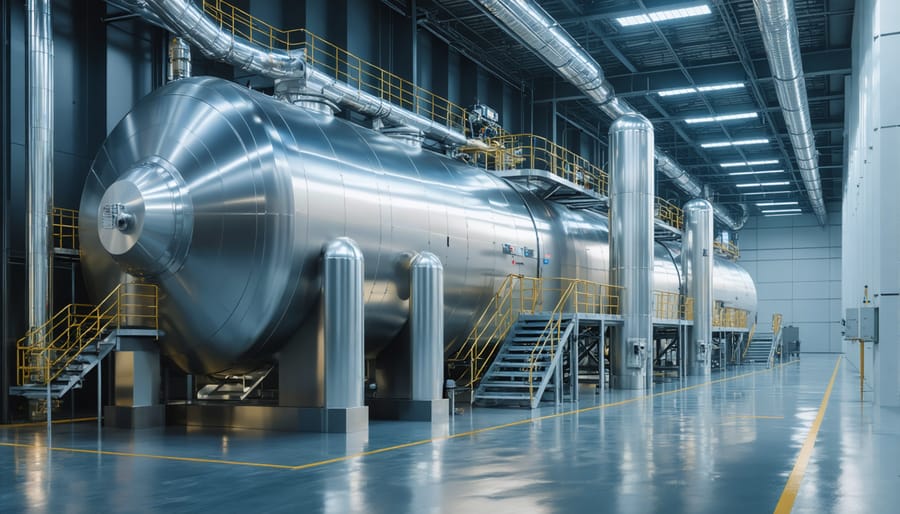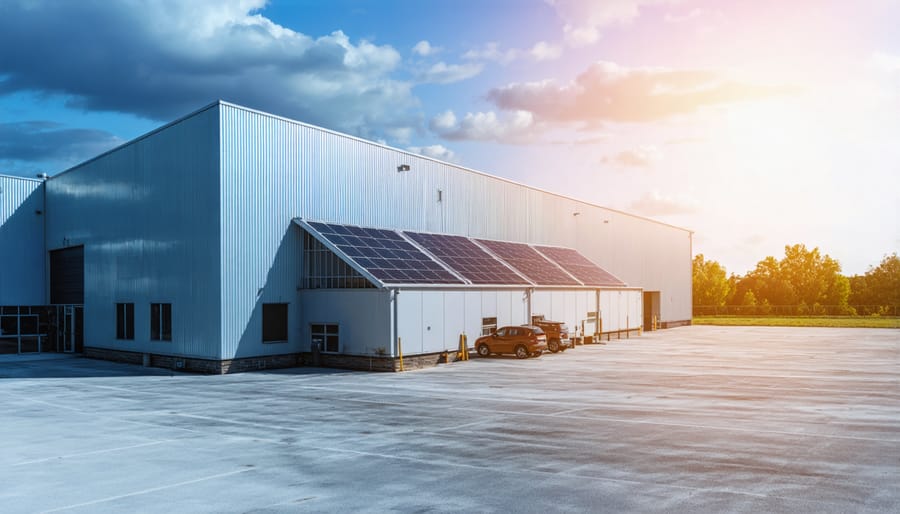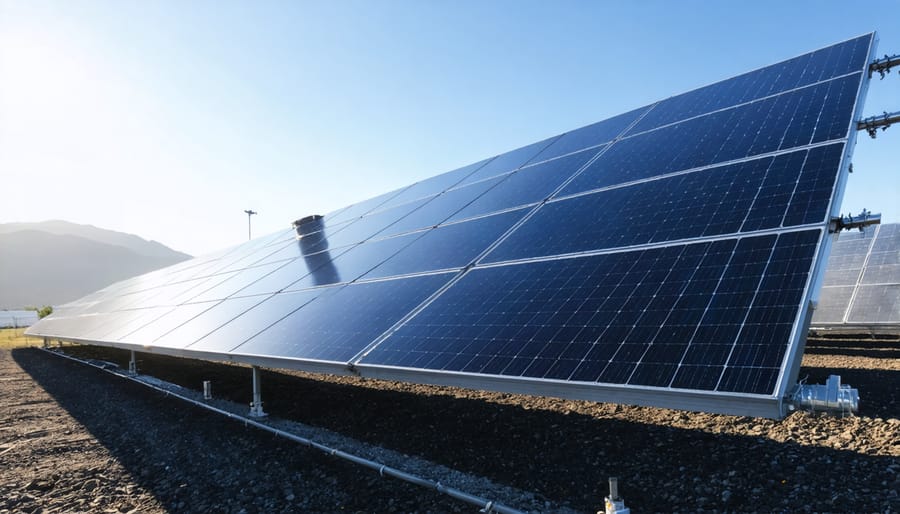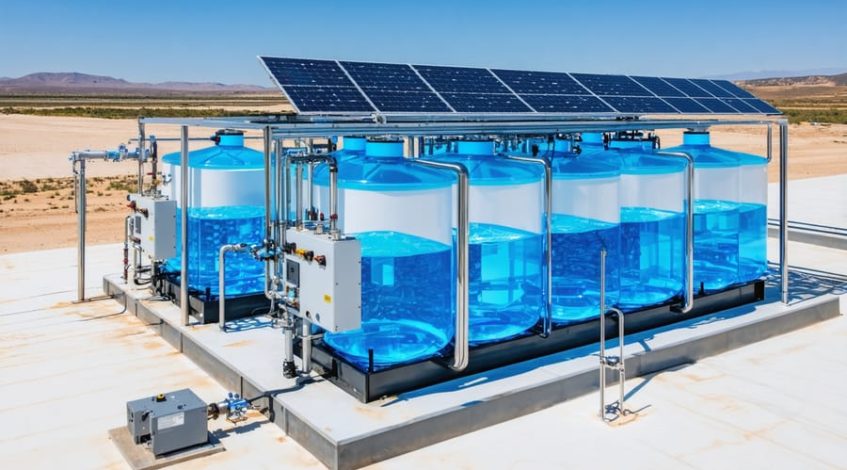Maximizing thermal energy storage efficiency stands at the forefront of modern sustainable energy management, offering businesses unprecedented opportunities to reduce operational costs while advancing environmental goals. Through advanced solar battery storage systems and thermal storage solutions, organizations can now achieve energy efficiency rates of up to 90%, dramatically transforming their energy consumption patterns and cost structures.
Recent technological breakthroughs in phase-change materials and molten salt storage have revolutionized how facilities store and utilize thermal energy, enabling storage durations of 10-15 hours at optimal efficiency levels. This advancement presents a compelling case for businesses seeking to maximize their renewable energy investments while ensuring consistent power availability during peak demand periods.
For facility managers and business leaders evaluating energy storage solutions, thermal storage efficiency has emerged as a critical metric that directly impacts both operational reliability and financial returns. With proper implementation, these systems can reduce peak energy costs by 30-50% while providing essential grid independence and sustainability benefits.
The Science Behind Thermal Energy Storage
Types of Thermal Storage Technologies
Thermal energy storage technologies can be categorized into three main types, each offering distinct advantages for different applications. Sensible heat storage, the most widely implemented method, involves raising or lowering the temperature of a storage medium without changing its phase. Common materials include water, thermal oils, and molten salts, with water being particularly cost-effective due to its high specific heat capacity and widespread availability.
Latent heat storage systems utilize phase change materials (PCMs) that absorb or release energy during phase transitions. These systems can store significantly more energy per unit volume compared to sensible heat storage, making them ideal for space-constrained facilities. Popular PCMs include paraffin waxes, salt hydrates, and organic compounds, each selected based on their melting point and application requirements.
Thermochemical storage, the most advanced of the three technologies, stores energy through reversible chemical reactions. While this method offers the highest energy density and minimal thermal losses during storage, it remains primarily in the development phase. Current research focuses on salt hydration reactions and metal oxide systems, which show promising potential for long-term seasonal storage applications.
The selection of an appropriate storage technology depends on various factors, including operating temperature range, storage duration requirements, space constraints, and cost considerations. Many modern facilities implement hybrid solutions, combining different storage types to optimize efficiency and meet specific operational demands. For example, a commercial building might use sensible heat storage for daily temperature regulation while incorporating PCMs for peak load management.

Integration with Solar Battery Systems
The integration of thermal energy storage with solar battery systems creates a comprehensive energy management solution that maximizes the efficiency and reliability of renewable energy installations. While traditional battery systems excel at storing electrical energy, thermal storage provides complementary benefits by capturing and preserving heat energy, which accounts for a significant portion of commercial and industrial energy needs.
When combined, these systems work synergistically to optimize energy utilization. During peak solar production hours, excess electrical energy can be directed to both battery storage and thermal storage units. The thermal storage component can efficiently maintain temperature control for facilities, reducing the load on traditional HVAC systems and freeing up battery capacity for other critical operations.
A notable example is the Desert Mountain High School in Arizona, where a hybrid storage system achieved a 40% reduction in overall energy costs. The facility’s thermal storage units handle temperature regulation during peak demand periods, while battery systems manage electrical loads for lighting and equipment.
The integration also enhances grid resilience. During power outages, thermal storage can maintain comfortable temperatures for extended periods without drawing from battery reserves, effectively extending the duration of backup power availability. This dual-storage approach typically delivers a 25-35% improvement in overall system efficiency compared to single-storage solutions, making it an increasingly attractive option for facilities seeking to optimize their renewable energy investments.
Efficiency Optimization Strategies
Temperature Management
Maintaining optimal temperature ranges is crucial for maximizing thermal energy storage efficiency. Research shows that how temperature affects energy storage efficiency can impact system performance by up to 30%. To achieve optimal results, implement automated temperature monitoring systems that maintain storage temperatures within ±2°C of the target range.
Best practices include installing high-quality insulation materials, implementing stratification techniques in liquid storage systems, and utilizing advanced control algorithms for temperature regulation. For commercial installations, maintaining phase change materials between 20-25°C during standard operation ensures consistent performance and longevity.
Regular temperature mapping and adjustment of thermal gradients help prevent energy losses and extend system lifespan. Industry leaders typically employ multi-sensor arrays connected to building management systems for real-time monitoring and automated adjustments. This approach has demonstrated energy savings of 15-20% in large-scale installations while reducing maintenance requirements and operating costs.
Insulation Technologies
Advanced insulation technologies play a crucial role in maximizing thermal energy storage efficiency. Modern storage systems utilize vacuum-insulated panels (VIPs) that achieve thermal conductivity values as low as 0.004 W/mK, significantly outperforming traditional materials. These panels incorporate microporous core materials surrounded by multi-layer metallic barriers, reducing heat loss by up to 90% compared to conventional insulation.
Aerogel-based insulation represents another breakthrough, offering superior thermal resistance while maintaining a lightweight profile. With thermal conductivity values around 0.015 W/mK, aerogels are particularly effective in high-temperature applications above 400°C. Leading facilities have reported energy savings of 30-40% after implementing aerogel insulation in their thermal storage systems.
Phase Change Materials (PCMs) integrated into insulation layers provide additional thermal management capabilities. These materials absorb and release heat during phase transitions, creating an active insulation system that responds to temperature fluctuations. Recent developments in nano-enhanced PCMs have improved their thermal conductivity by up to 25%, resulting in more efficient heat transfer and storage capabilities.
The selection of appropriate insulation technology depends on specific application requirements, operating temperatures, and cost considerations. A comprehensive cost-benefit analysis should account for both initial investment and long-term energy savings.

Control Systems
Advanced control systems are essential for maximizing thermal energy storage efficiency through intelligent monitoring and automation. Modern Building Management Systems (BMS) integrate thermal storage operations with real-time data analytics, allowing facility managers to optimize charging and discharging cycles based on energy demand patterns and utility rates.
Smart sensors throughout the storage system continuously monitor temperature distributions, flow rates, and thermal stratification levels. This data feeds into predictive algorithms that adjust system parameters to maintain optimal performance. Weather forecasting integration enables proactive system adjustments, particularly valuable for solar thermal applications.
Automated controls manage load shifting strategies, ensuring stored thermal energy is utilized during peak demand periods when utility costs are highest. These systems can also coordinate multiple storage units in large facilities, balancing loads and maintaining system efficiency across the entire installation.
Remote monitoring capabilities allow facility managers to track performance metrics, receive maintenance alerts, and adjust settings from any location. Cloud-based platforms provide detailed analytics on system efficiency, cost savings, and environmental impact, helping organizations demonstrate ROI and meet sustainability goals.
Many modern control systems also feature machine learning capabilities that continuously improve system performance by learning from operational patterns and environmental conditions. This adaptive approach ensures the storage system maintains peak efficiency throughout its operational life while minimizing human intervention requirements.

ROI and Performance Metrics
Energy Cost Savings
Implementing thermal energy storage systems can lead to substantial cost reductions through various mechanisms. Understanding key energy storage cost considerations is crucial for maximizing financial benefits.
Peak demand charge reduction typically represents the most significant savings opportunity, often delivering 20-30% cuts in utility costs. By shifting energy consumption to off-peak hours, businesses can substantially reduce their peak demand charges while maintaining operational efficiency.
Time-of-use arbitrage presents another valuable savings avenue. Organizations can store energy during low-cost periods and utilize it during high-rate times, potentially achieving 15-25% savings on energy expenditure. This strategy proves particularly effective in regions with significant rate differentials between peak and off-peak periods.
Additional cost benefits emerge through improved grid independence and reduced transmission losses. Facilities implementing thermal storage systems report average annual energy cost reductions of 30-40% when the system is optimally configured and maintained.
Real-world implementations demonstrate consistent returns on investment within 3-5 years, with some facilities achieving payback periods as short as 2 years in high-utility-cost regions. These savings calculations factor in maintenance costs, system efficiency, and potential utility incentives, providing a comprehensive view of long-term financial benefits.
System Longevity Benefits
Implementing thermal energy storage systems significantly enhances system longevity while reducing maintenance requirements across the entire energy infrastructure. By effectively managing temperature fluctuations and peak load demands, these systems minimize stress on critical components, potentially extending equipment lifetime by 20-30%.
The integration of thermal storage solutions particularly benefits heating and cooling equipment by reducing cycling frequency and preventing sudden temperature changes. This steady operation translates to fewer mechanical wear incidents and decreased maintenance costs over time. Studies have shown that facilities implementing thermal storage systems experience up to 40% reduction in maintenance-related downtime.
Moreover, thermal storage systems act as buffers against extreme operating conditions, protecting expensive equipment from thermal stress and mechanical fatigue. This protective function is especially valuable in industrial applications where continuous operation is critical. Facility managers report significant reductions in emergency repairs and replacement costs after implementing thermal storage solutions.
The modular nature of modern thermal storage systems also allows for easier maintenance scheduling and component replacement when necessary. This flexibility enables facility operators to perform preventive maintenance without disrupting operations, further contributing to the overall system reliability and longevity. Organizations typically observe ROI improvements of 15-25% through reduced maintenance costs and extended equipment life spans.
Thermal energy storage efficiency continues to evolve as a critical component in sustainable energy management. As demonstrated throughout this analysis, successful implementation depends on selecting appropriate storage technologies, optimizing system design, and maintaining operational excellence. The data shows that well-designed thermal storage systems can achieve efficiency rates of 80-90%, significantly reducing energy costs and carbon emissions.
Looking ahead, emerging technologies and improved materials promise even greater efficiency gains. Advanced phase change materials, enhanced thermal conductivity solutions, and smart control systems are set to revolutionize the industry. These developments, combined with decreasing installation costs and increasing energy prices, make thermal storage an increasingly attractive investment for businesses and facilities.
Organizations implementing thermal storage systems today are positioning themselves at the forefront of energy efficiency and sustainability. As regulatory requirements tighten and environmental concerns grow, the role of thermal energy storage will become increasingly vital. By carefully considering system design, implementation strategies, and maintenance protocols outlined in this guide, facilities can maximize their return on investment while contributing to a more sustainable energy future.

